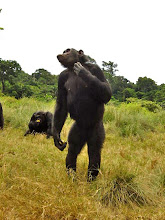 ..far into the deep woods of northern Gotland, I found her, the wonderfully scented
..far into the deep woods of northern Gotland, I found her, the wonderfully scentedLesser butterfly-orchid!
(Nattviol, in Swedish)
 The forest was filled with a variety of orchids - en masse! Trips to these areas must have been a highlight in Swedish botanist, physician, and zoologist, Carl von Linné´s (who laid the foundations for the modern scheme of binomial nomenclature) excursions all over Gotland in the mid 1800-century.
The forest was filled with a variety of orchids - en masse! Trips to these areas must have been a highlight in Swedish botanist, physician, and zoologist, Carl von Linné´s (who laid the foundations for the modern scheme of binomial nomenclature) excursions all over Gotland in the mid 1800-century. Sunday, we went with a group of people and a guide to visit the iron age (500 BC – 800 AD) village of Höglundar (by Garde gård, Stenkyrka), deep into the woods. During this period, the climate in the Nordic area grew colder. Rainy summers and harsher winters led to lower yields from crops and farm animals. When iron came to the North in about 500 BC, it brought with it considerable changes however. Unlike bronze, iron was an inexpensive metal that could be used in everyday life – for tools, weapons and many other things.
Sunday, we went with a group of people and a guide to visit the iron age (500 BC – 800 AD) village of Höglundar (by Garde gård, Stenkyrka), deep into the woods. During this period, the climate in the Nordic area grew colder. Rainy summers and harsher winters led to lower yields from crops and farm animals. When iron came to the North in about 500 BC, it brought with it considerable changes however. Unlike bronze, iron was an inexpensive metal that could be used in everyday life – for tools, weapons and many other things. The we spotted the foundation of a typical Gotland long house (I have one like this just behind my house!)
The we spotted the foundation of a typical Gotland long house (I have one like this just behind my house!) (A reconstruction in Gotland)
(A reconstruction in Gotland)where people once lived together with their cattle in these areas of rather poor soil. Some evidence of farming has been discovered though, in the lower, more fertile areas of Höglundar.
In the 6th century, Gotland went into economic decline; as trade became more difficult and violence and plundering became more common. Perhaps this is the reason that many farms were abandoned and burned, many fortunes were buried, and the great defensive forts were built.
During this period, the dead were buried in large grave fields. Superficially, the grave fields appear to be very modest affairs, but they often contain rich assemblages of weapons, jewellery, coins and glass. At Höglundar, the many graves are shallow because of the stony ground conditions, and the corpses are buried in limestone coffins under the cairns.
 Our guide, Per-Åke, (sitting, ) is himself living on farm close to Lickershamn not far from where we were, which stands on the foundtions of a iron-age dwelling. The farm has been passed on for "he did not quite know many gererations!" There he found the skeleton of "Gotland´s oldest human being" some years ago. It is now placed in the Gotland Fornsal museum. He has also found a number of treasures on his farm: silver, iron items, brons and claypots.
Our guide, Per-Åke, (sitting, ) is himself living on farm close to Lickershamn not far from where we were, which stands on the foundtions of a iron-age dwelling. The farm has been passed on for "he did not quite know many gererations!" There he found the skeleton of "Gotland´s oldest human being" some years ago. It is now placed in the Gotland Fornsal museum. He has also found a number of treasures on his farm: silver, iron items, brons and claypots.Here the group studying the layout of the iron age village.
 A beautiful Juniper tree in the middle of the Höglundar woodlands!
A beautiful Juniper tree in the middle of the Höglundar woodlands!Increased trade eventually led to increased prosperity on the island. New farms sprang up on Gotland, and the first longhouses began to appear; they were built on solid stone foundations and had high roofs.
Today we know of about 1,500 dwelling foundations of this sort, some of them over 50 metres long. In days gone by, they were called kämpagravar – giants’ graves.
Ironworking thus became an important craft, and the smiths made many items that the merchants could sell. The Roman Empire was at its height during the second century AD. Its border with the Germanic tribes followed the courses of the Rhine and Danube. Many of the archaeological finds unearthed on Gotland show that there was extensive trade with the Roman Empire and Germanic tribes.
At the many trading centres along the Baltic, furs, skins, salt, glass, wine and other commodities were eagerly exchanged. (info: by Gotland Tourist Information)






































Inga kommentarer:
Skicka en kommentar